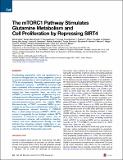The mTORC1 Pathway Stimulates Glutamine Metabolism and Cell Proliferation by Repressing SIRT4
Author(s)
Csibi, Alfred; Fendt, Sarah-Maria; Li, Chenggang; Poulogiannis, George; Choo, Andrew Y.; Chapski, Douglas J.; Jeong, Seung Min; Dempsey, Jamie M.; Parkhitko, Andrey; Morrison, Tasha; Henske, Elizabeth P.; Haigis, Marcia C.; Cantley, Lewis C.; Stephanopoulos, Gregory; Yu, Jane; Blenis, John; ... Show more Show less
DownloadStephanopoulos_The mTORC1.pdf (1.536Mb)
PUBLISHER_POLICY
Publisher Policy
Article is made available in accordance with the publisher's policy and may be subject to US copyright law. Please refer to the publisher's site for terms of use.
Terms of use
Metadata
Show full item recordAbstract
Proliferating mammalian cells use glutamine as a source of nitrogen and as a key anaplerotic source to provide metabolites to the tricarboxylic acid cycle (TCA) for biosynthesis. Recently, mammalian target of rapamycin complex 1 (mTORC1) activation has been correlated with increased nutrient uptake and metabolism, but no molecular connection to glutaminolysis has been reported. Here, we show that mTORC1 promotes glutamine anaplerosis by activating glutamate dehydrogenase (GDH). This regulation requires transcriptional repression of SIRT4, the mitochondrial-localized sirtuin that inhibits GDH. Mechanistically, mTORC1 represses SIRT4 by promoting the proteasome-mediated destabilization of cAMP-responsive element binding 2 (CREB2). Thus, a relationship between mTORC1, SIRT4, and cancer is suggested by our findings. Indeed, SIRT4 expression is reduced in human cancer, and its overexpression reduces cell proliferation, transformation, and tumor development. Finally, our data indicate that targeting nutrient metabolism in energy-addicted cancers with high mTORC1 signaling may be an effective therapeutic approach.
Date issued
2013-05Department
Massachusetts Institute of Technology. Department of Chemical EngineeringJournal
Cell
Publisher
Elsevier
Citation
Csibi, Alfred, Sarah-Maria Fendt, Chenggang Li, George Poulogiannis, Andrew Y. Choo, Douglas J. Chapski, Seung Min Jeong, et al. “The mTORC1 Pathway Stimulates Glutamine Metabolism and Cell Proliferation by Repressing SIRT4.” Cell 153, no. 4 (May 2013): 840–854. © 2013 Elsevier Inc.
Version: Final published version
ISSN
00928674
1097-4172